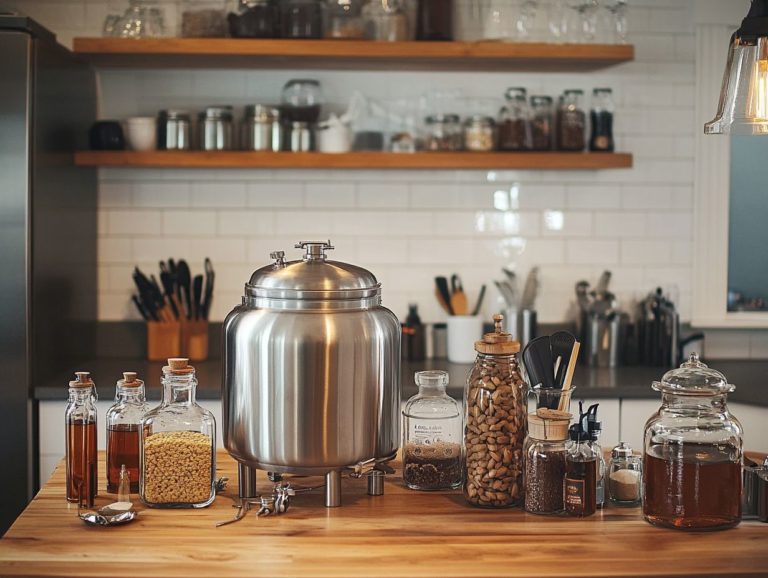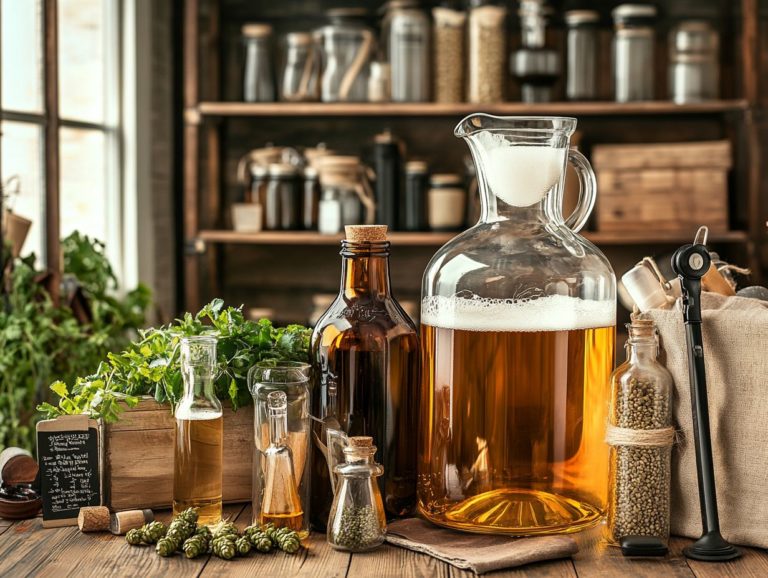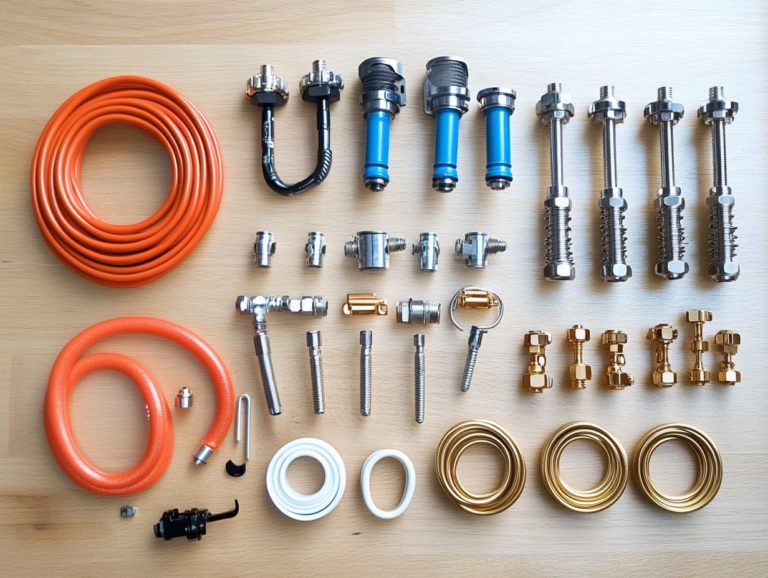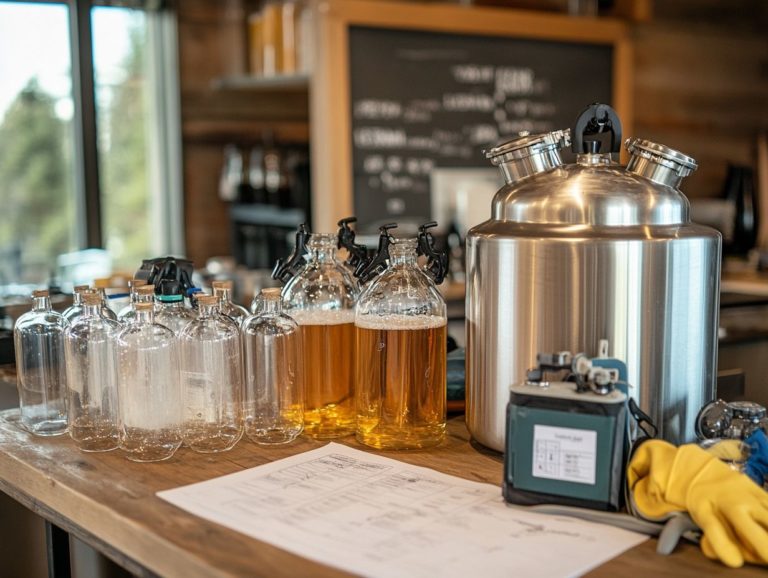How to Troubleshoot Brewing Equipment Issues
Contents
- How to Troubleshoot Brewing Equipment Issues
- Key Takeaways:
- Common Brewing Equipment Issues
- How to Troubleshoot These Issues
- Preventative Maintenance Tips
- Essential Brewing Maintenance Tips
- When to Call a Professional
- Frequently Asked Questions
- 1. What are the common issues that can arise with brewing equipment?
- 2. How can I troubleshoot a leaking brewing equipment?
- 3. My brewing equipment is not heating up properly. What could be the problem?
- 4. How do I fix a clog in my brewing equipment?
- 5. What should I do if my brewing equipment is not producing consistent temperature?
- 6. My brewing equipment has a broken part. Can I fix it myself?
How to Troubleshoot Brewing Equipment Issues
Brewing your favorite beverages at home can be an incredibly rewarding experience. However, equipment issues can swiftly transform that joy into frustration.
From annoying leaks to unpredictable temperatures, common brewing challenges can significantly disrupt your brewing process. Get ready to tackle those brewing challenges with confidence!
You’ll also discover proactive maintenance tips to keep your brewing equipment in excellent condition and learn precisely when it s best to enlist the help of a professional.
Prepare to elevate your brewing game to new heights with improved brewing knowledge!
Key Takeaways:
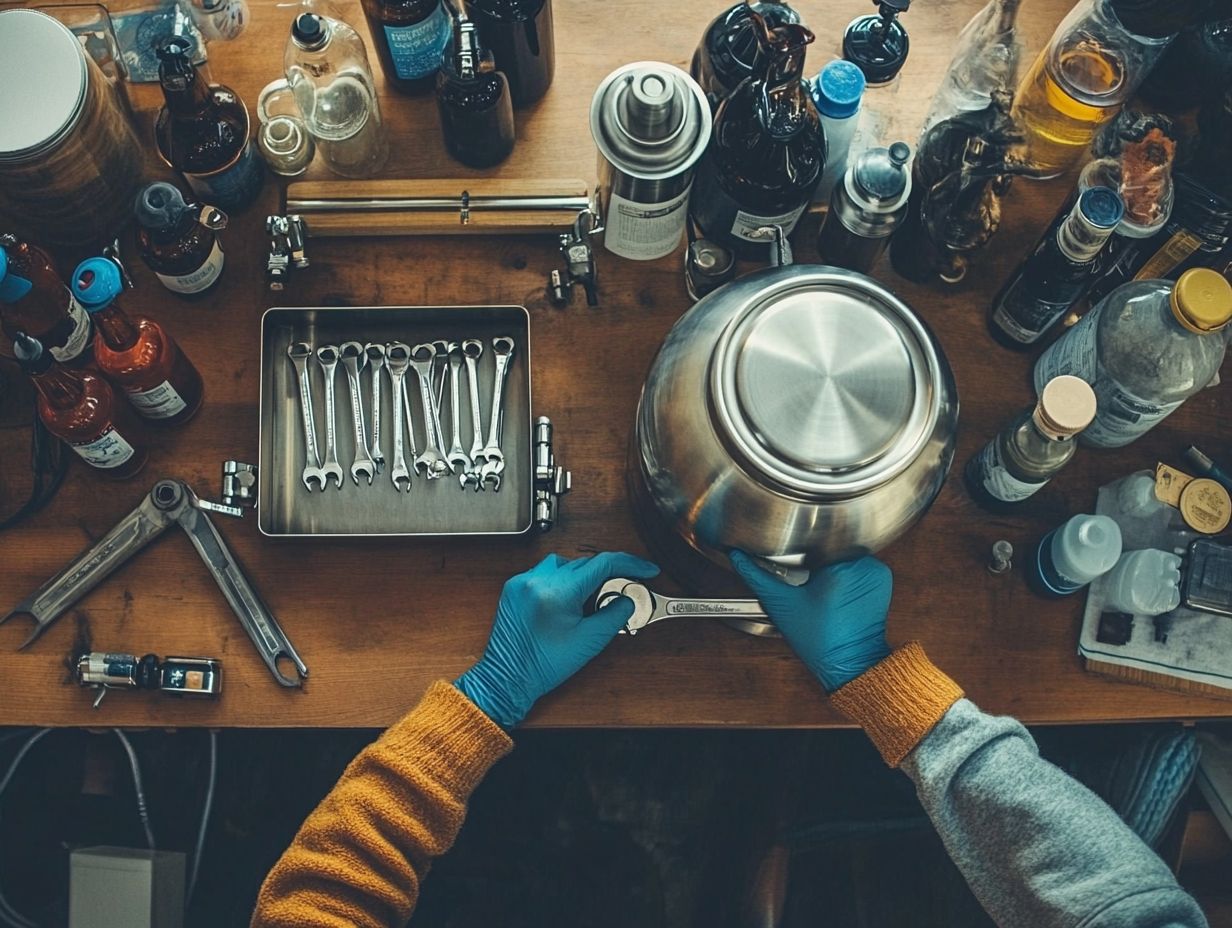
- Regular maintenance and cleaning are key to preventing common brewing equipment issues like leaks and clogged filters.
- Troubleshooting steps such as checking for leaks and increasing water pressure can resolve low water flow and inconsistent temperature issues.
- Following the manufacturer’s instructions, using quality water and ingredients, and storing equipment properly can prevent future brewing equipment issues.
Common Brewing Equipment Issues
Common brewing equipment issues can profoundly influence your brewing process, impacting everything from fermentation health to the final product’s quality. Problems like leaks, low water pressure, and clogged filters can create brewing challenges that lead to inconsistent temperatures and compromised sanitation.
Recognizing these issues is crucial for any brewery be it a microbrewery or a larger commercial operation if you aim to achieve optimal brewing results and uphold the highest standards of beer quality through effective fermentation control and proper brewing adjustments.
1. Leaks
Leaks in brewing equipment can throw a wrench in your entire brewing process, resulting in significant ingredient losses and potential contamination.
These leaks often stem from faulty piping or worn-out valves. They can lead to financial losses and compromise the quality of your beer. To counter these challenges, it s essential to establish regular maintenance schedules and carry out thorough inspections of your systems.
By pinpointing and addressing vulnerable areas like corroded pipes or improperly sealed fittings you can effectively reduce the risk of leaks. Training your staff to recognize the early signs of leaks can be a game changer in preventing costly mishaps, ensuring that every batch of beer meets the high quality your customers expect through rigorous brewing inspections.
2. Low Water Pressure
Low water pressure can pose significant challenges in your brewing process, impacting everything from mash efficiency to the operation of your fermentation tank.
When your water pressure falls short, inconsistencies in water chemistry can arise, which are crucial for extracting the right flavors and aromas from your ingredients. For example, low pressure might prevent the even distribution of hot water during mashing, leading to incomplete sugar extraction and a less flavorful wort (the liquid extracted from the mash, crucial for flavor development). Furthermore, during fermentation, inadequate pressure can hinder yeast performance, potentially resulting in stalled fermentation or unwanted off-flavors.
To tackle these challenges, you can implement pressure regulators and pumps to maintain a steady flow. Alternatively, consider adjusting your brewing techniques, such as extending steeping times, to maximize extraction even under lower pressure conditions and ensure optimal brewing conditions.
3. Clogged Filters
Clogged filters can significantly hinder your brewing process, leading to fermentation issues and resulting in weak flavors in your final product. This obstruction slows down fermentation and makes it more difficult to reach your desired alcohol content. It can also introduce unwanted bitterness that detracts from the overall taste.
As sediment accumulates, it disrupts the flow of liquid, preventing the full expression of your carefully selected ingredients. To sidestep these pitfalls, regular maintenance is essential. Clean your filters thoroughly after each use. A simple soak in a mixture of water and vinegar, followed by a gentle scrub to eliminate any residue, will do wonders.
Keeping your filters clear will markedly enhance the quality and consistency of every brew you create, ensuring that your brewing equipment maintenance is up to par.
4. Malfunctioning Heating Element
A malfunctioning heating element in your brewing equipment can lead to inconsistent temperatures, significantly impacting both the mash and fermentation processes.
This inconsistency disrupts the delicate balance necessary for effective fermentation, as yeast flourishes within a specific temperature range. Ensuring optimal heating is crucial, as it supports enzyme activity during mashing. This influences not only the sugars available for fermentation but also the overall flavor profile of your beer. If fermentation temperatures stray too far from the ideal range, you may encounter sluggish or stalled fermentation, resulting in off-flavors and a lack of the desired characteristics.
To troubleshoot these issues, you should:
- Regularly calibrate your temperature sensors,
- Monitor hotspots within the mash tun, and
- Invest in high-quality heating elements that can deliver reliable and consistent heat.
Make regular maintenance checks your brewing ritual to catch problems early and enhance your brewing styles.
5. Inconsistent Temperature
Inconsistent temperatures during the brewing process can create a host of fermentation issues, ultimately compromising the quality of your beer. Fluctuating temperatures can disrupt yeast activity, leading to undesirable flavors or even a complete stall in fermentation. Maintaining a steady temperature is essential for achieving the desired flavor profile in your final product.
To navigate this challenge, many brewers turn to techniques such as temperature-controlled fermentation vessels, effective insulation, and the practice of cold crashing to create an optimal environment. By implementing these strategies, you can make the brewing process more predictable, ensuring that the yeast remains active and efficient throughout fermentation, thus enhancing your brewing results.
A consistent temperature protects the quality of your beer and elevates its flavor and aroma, resulting in a more enjoyable experience for the consumer.
6. Poor Water Flow
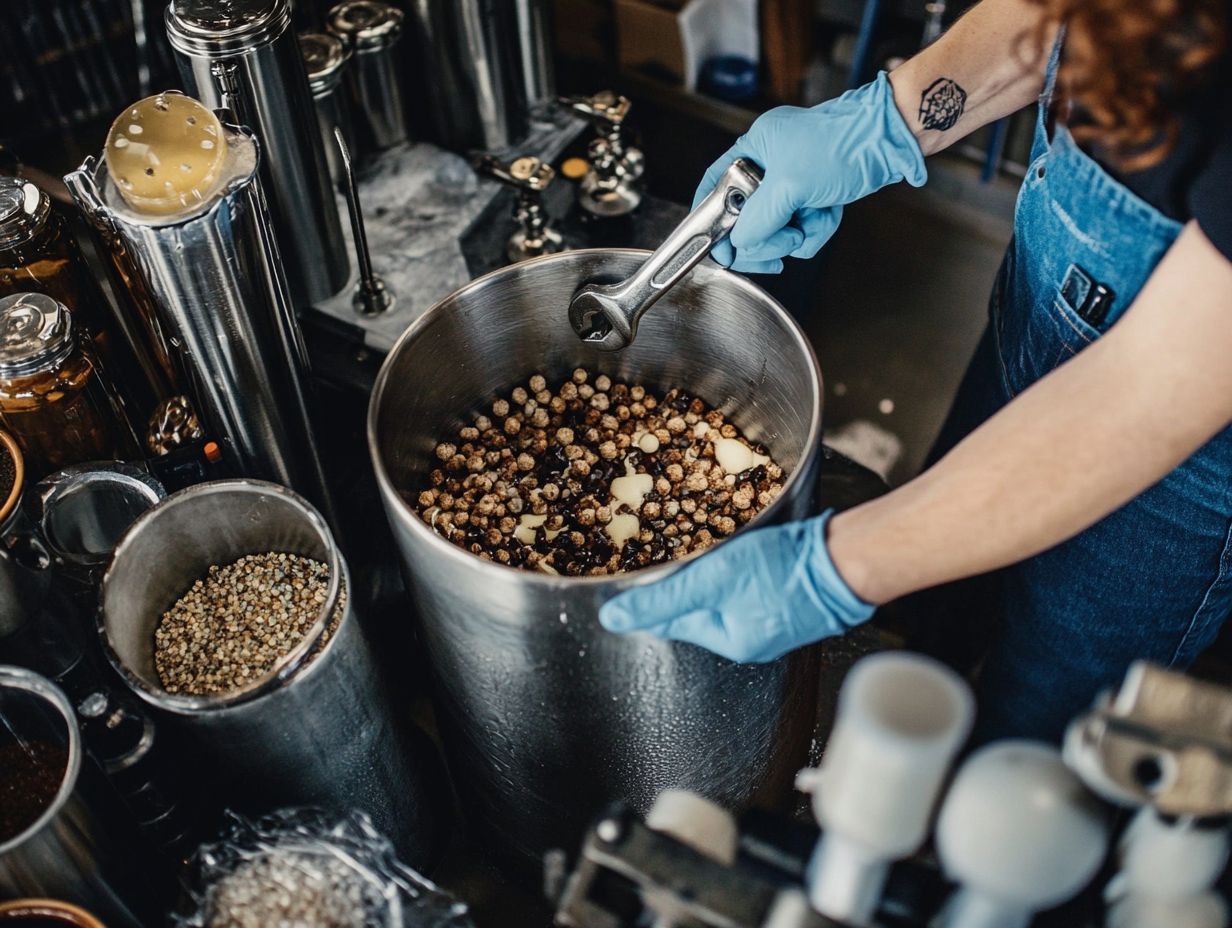
Poor water flow in your brewing equipment can lead to significant inefficiencies in water usage and ultimately impact your brewing performance.
This issue may result in imbalanced brewing ratios, where the ratio of water to coffee or tea is less than optimal. This can lead to under-extraction, resulting in weak flavors, or over-extraction, causing bitterness. Improper water flow disrupts the delicate chemistry of the brewing process, affecting dissolved solids and extraction rates.
To address these challenges, enhance flow by regularly maintaining your equipment, utilizing pumps that deliver consistent pressure, or incorporating flow restrictors to ensure optimal water distribution. These adjustments not only boost efficiency but also elevate the overall quality of your brew and improve your brewing business.
How to Troubleshoot These Issues
Troubleshooting your brewing equipment is essential for upholding a high-quality brewing process and ensuring that every batch aligns with your standards of excellence. To effectively tackle any issues, it s vital to pinpoint the root causes be it leaks or low water pressure. Employ the appropriate troubleshooting techniques to address these issues.
By conducting regular inspections and maintaining your brewing setup, including thorough cleaning and addressing brewing errors, you can prevent common problems before they disrupt fermentation and compromise the quality of your beer. Proper troubleshooting is key to maintaining your brewing quality.
1. Check for Leaks
To ensure you’re producing a quality product, regularly inspect your brewing equipment for any leaks that could lead to contamination or loss of precious ingredients.
A careful visual inspection can reveal signs of moisture accumulation or corrosion. These are clear indicators of potential leaks. Implementing pressure tests allows for a thorough evaluation of the system’s integrity. Any drop in pressure during these tests can alert you to a problem area that needs immediate attention.
By addressing leaks promptly, you preserve the flavor and aroma of your brew and prevent costly waste of raw materials.
Don t let leaks jeopardize your brewing! Neglecting these issues can lead to poor sanitation, impacting the quality and consistency of your final product.
2. Increase Water Pressure
Increasing water pressure in your brewing system can significantly enhance efficiency, ensuring that every aspect of the brewing process, including sanitation, is executed flawlessly.
Maintaining optimal water pressure is crucial. It helps you be more precise in your brewing and averts potential problems from low pressure. You can adjust your valve settings or consider investing in a pressure booster pump to guarantee a steady flow of water. Regularly inspect and clear any clogs in your plumbing, including pipes and valves, to improve performance.
A well-maintained plumbing system elevates the quality of your brews and contributes to a smoother operation. This leads to better-tasting beers, improved yeast vitality, and happier customers.
3. Clean or Replace Filters
Cleaning or replacing filters is an essential maintenance step to ensure your brewing equipment operates effectively and to prevent fermentation issues.
Neglecting this process can lead to the accumulation of unwanted substances that compromise the quality of your beer and disrupt brewing. For both enthusiasts and professional brewers, maintaining clean filters is vital. Clean filters facilitate the flow of brewing ingredients while capturing impurities that could spoil your final product.
Inspect and clean these filters regularly typically after every few batches and replace them based on the materials used and your brewing frequency. This practice enhances the taste and aroma of your beer, ensuring the longevity of your brewing system and preventing brewing errors.
4. Test and Replace Heating Element
Regularly testing and replacing the heating element in your brewing equipment is crucial for maintaining optimal brewing temperatures throughout the entire brewing process.
Neglecting this task can lead to inconsistent brewing conditions, ultimately compromising the quality of your final product. To effectively assess the heating element, you can use a multimeter, a device that measures electrical resistance, to check its resistance, ensuring it falls within the manufacturer s specified range.
If your readings show an open circuit or significantly high resistance, it s a clear sign that the heating element needs to be replaced. Proper heating also affects the original gravity and mash efficiency of your wort.
Be on the lookout for signs such as slow heating times or uneven temperatures during the brewing process; these are critical indicators of potential issues. A well-functioning heating element guarantees that your water reaches the desired temperature, essential for extracting the full flavor profile and aroma from your coffee grounds or tea leaves.
5. Calibrate Temperature Controls
Calibrating your temperature controls is essential for ensuring that the brewing process stays within the ideal temperature range, which is crucial for optimal fermentation control. Even slight temperature deviations can significantly impact the flavor, aroma, and overall quality of your final product.
Regularly check your temperature gauges for accuracy, using calibrated thermometers or temperature probes suitable for your specific brewing system. Establish a routine maintenance schedule to verify and adjust these calibration tools.
Investing in high-quality temperature monitoring equipment enhances the precision of your temperature settings, ultimately leading to a more consistent and reliable brewing process. This is essential for maintaining proper brewing temperatures and ensuring the best brewing results.
Consider using digital controllers equipped with alarms that notify you when temperatures stray from the set range. This can be incredibly beneficial in preventing potential brewing issues and ensuring consistent brewing conditions.
6. Clean and Descale Equipment
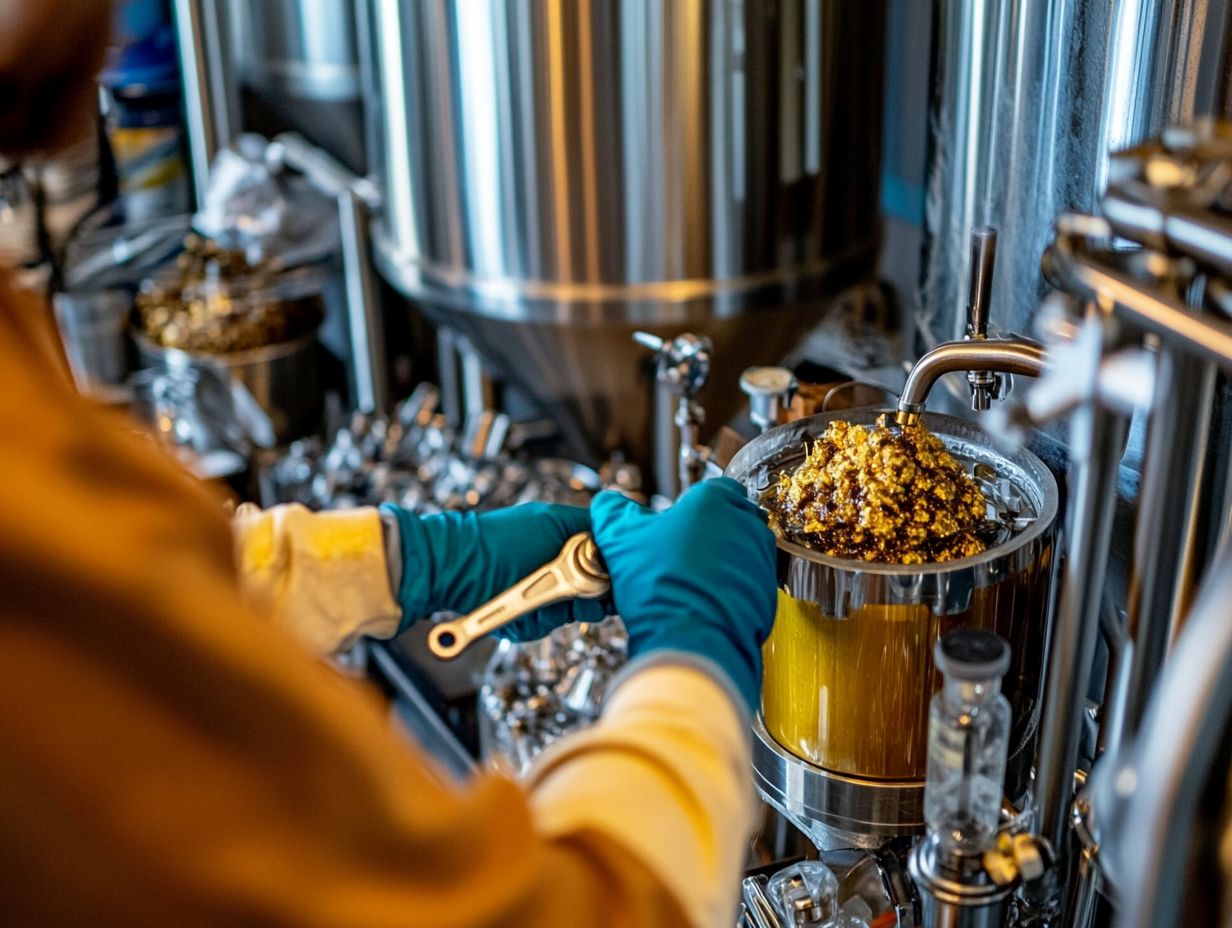
Regularly cleaning and descaling your brewing equipment is essential for preserving brewing quality and avoiding fermentation issues, such as slow fermentation or weak flavors.
Neglecting this crucial practice can lead to a buildup of residue and mineral deposits that detract from the flavor and aroma of your final product. Employ techniques such as using specialized cleaning solutions that target stubborn stains and descaling agents that effectively eliminate limescale; these are vital to the process.
By incorporating these products into your routine maintenance schedule, you can enhance flavor extraction and ensure optimal yeast performance. A clean brewing setup improves efficiency during production and significantly minimizes the risk of unwanted off-flavors and carbonation problems. Ultimately, this leads to a more consistent and enjoyable beverage.
Preventative Maintenance Tips
Implementing preventative maintenance tips for your brewing equipment can conserve both time and resources, ultimately resulting in a higher quality product and fewer brewing challenges, such as poor sanitation and inconsistent temperatures.
Regular inspections, effective cleaning techniques, and adherence to brewing resources are essential practices for any brewery seeking to excel in a competitive market, whether you operate a microbrewery or a larger commercial establishment. This includes keeping up with the latest brewing techniques and incorporating the best brewing methods.
By prioritizing preventative measures, you can address potential issues such as poor sanitation, inconsistent temperatures, and fermentation problems before they develop into significant setbacks.
Start implementing these tips today to ensure your brewing equipment remains in top shape!
Essential Brewing Maintenance Tips
1. Regularly Clean and Inspect Equipment
Regularly cleaning and inspecting your brewing equipment is essential for ensuring top-notch brewing quality and efficiency.
To maintain a pristine brewing environment, it’s crucial to establish a detailed cleaning plan that includes daily, weekly, and monthly tasks tailored to your specific equipment. By sanitizing your fermenting containers after each use, you must prevent unwanted bacterial growth!
Don’t overlook the importance of inspecting hoses and fittings periodically. This practice helps you identify wear or contamination risks before they become larger issues. Make sure your keg cleaning methods are thorough to prevent any potential contamination in your brews.
Utilizing the right cleaning agents, along with scrubbing and rinsing techniques, will help you eliminate any residues that could compromise the final product. Incorporating a checklist for equipment inspections not only enhances accountability but also keeps your brewing process running smoothly, minimizing fermentation problems.
2. Use Quality Water and Ingredients
Using high-quality water and ingredients is crucial for elevating your beer brewing process. It influences everything from the intricate flavor profile to the overall health of fermentation.
Water chemistry is a key player in this equation, as it directly impacts various brewing factors such as pH levels, mineral content, and clarity. These factors shape the final product’s taste and stability.
When choosing your water, consider its mineral profile to ensure it aligns with the desired beer style. This creates an optimal mash environment for enzyme activity. Using appropriate brewing salts can adjust the water chemistry to your needs, enhancing overall brewing results.
The quality of your ingredients, particularly the freshness of hops and malts, is something you can’t afford to overlook. Testing your water for hardness and alkalinity helps you make necessary adjustments. Sourcing your ingredients from reputable suppliers sets you up for a superior outcome.
Together, these elements lay a solid foundation for brewing excellence. Utilizing the right malt mill can ensure you get the freshest and most consistent crush, improving your mash efficiency and overall brewing quality.
3. Follow Manufacturer’s Instructions
Following the manufacturer s instructions for your brewing equipment is absolutely essential for achieving optimal performance and avoiding any brewing mishaps that could compromise your final product.
This includes understanding proper yeast selection and its impact on the fermentation health of your brews. Disregarding these guidelines can result in unnecessary wear and tear on your machinery, leading to costly repairs or even complete equipment failure.
Proper setup, operation, and maintenance aren t just casual suggestions; they are critical practices that ensure the longevity and reliability of your brewing process. By adhering to the recommendations laid out by the manufacturers, you can achieve consistency in taste and quality while maximizing your equipment s efficiency!
Ultimately, this commitment pays off, enhancing both the craft of brewing and its business aspects. It creates an exceptional experience for both you and your consumers.
4. Store Equipment Properly
Properly storing your brewing equipment is essential to effective brewing practices. It protects your tools from damage and ensures their longevity.
To maintain the integrity of your tools and elevate the quality of your brews, be mindful of specific storage conditions. Humidity and temperature fluctuations can create the perfect environment for mold growth or rust. Therefore, find a cool, dry place for your equipment.
Proper storage practices are crucial for all brewing systems, whether you’re running a small microbrewery or a large commercial operation. Before storing, ensure all equipment is thoroughly cleaned and dried to avoid any contamination or residue buildup.
Utilizing protective covers will help mitigate the risks posed by dust and debris. Additionally, organizing your equipment in a way that prevents scratching or collisions will further safeguard their condition.
Conclusion
In summary, maintaining your brewing equipment is vital for achieving outstanding results. Regular cleaning, using quality ingredients, following manufacturer instructions, and proper storage all play a significant role in your brewing success. By implementing these best practices, you will ensure a seamless brewing process and exceptional beer quality!
When to Call a Professional
Understanding when to enlist a professional for brewing equipment issues is crucial for any brewery striving to maintain operational efficiency and uphold product quality. Don t wait until it s too late call a professional immediately. Professionals can offer valuable brewing troubleshooting skills to address brewing errors that may be beyond your knowledge or capability.
If you encounter unexpected fermentation challenges, such as stalled yeast activity or peculiar off-flavors, or even slow fermentation and weak flavors, tapping into a professional’s expertise can quickly help you identify the root cause and improve your overall brewing process.
When faced with advanced equipment malfunctions, such as pump failures or temperature control discrepancies, an experienced technician can offer insights and repairs that may be beyond the reach of the average brewer. However, for those looking to tackle these issues independently, knowing how to troubleshoot home brewing equipment can be invaluable. Issues with poor sanitation and piping and valves also require professional attention.
To ensure your brews consistently meet high standards, it s essential to adopt a proactive approach to equipment maintenance. This includes regular brewing equipment maintenance and brewing inspections. Do not hesitate to seek assistance when safety concerns arise or when critical brewing stages are in jeopardy.
Keeping open lines of communication with professionals can significantly impact the preservation of both product integrity and brewing quality, leading to overall operational success in your brewing business.
Frequently Asked Questions
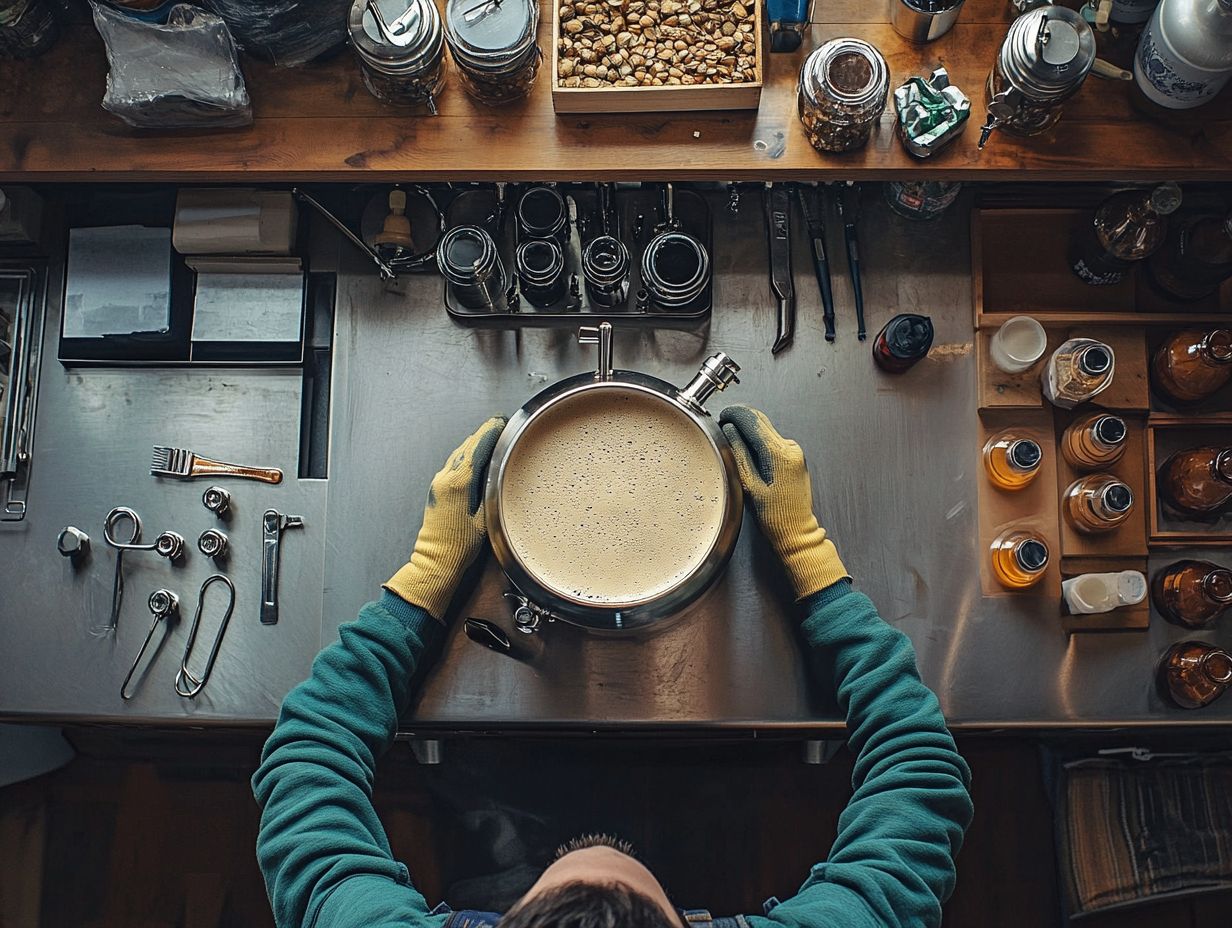
1. What are the common issues that can arise with brewing equipment?
Some common issues include leaks, clogs, temperature inconsistencies, broken parts, and fermentation issues.
2. How can I troubleshoot a leaking brewing equipment?
First, check all connections and fittings to make sure they are securely tightened. If the leak persists, inspect the equipment for any cracks or damage. If found, replace the damaged part. If not, contact the manufacturer for further assistance. Proper sanitation and regular cleaning of equipment can also prevent leaks.
3. My brewing equipment is not heating up properly. What could be the problem?
The heating element or thermostat may be faulty. Check these components and replace them if necessary. Also, ensure the power source is working and that the equipment is plugged in properly. Monitoring brewing temperatures is crucial for consistent results.
4. How do I fix a clog in my brewing equipment?
If the clog is in the tubing or pipes, try using a specialized cleaning solution or manually clearing the blockage with a brush. If the clog is in a filter, replace it with a new one. In some cases, disassembling and cleaning the equipment may also help. Ensuring mash efficiency and using appropriate brewing methods can prevent clogs.
5. What should I do if my brewing equipment is not producing consistent temperature?
Check the thermostat and heating element for any damage or malfunction. If they seem to be working properly, ensure the equipment is in a well-ventilated area and not exposed to extreme temperatures. If the issue persists, contact the manufacturer for further assistance. Accurate temperature control is vital for a smooth brewing process.
6. My brewing equipment has a broken part. Can I fix it myself?
It depends on the part and your level of expertise. Some parts may be easily replaceable with basic tools, while others may require professional help. It’s always best to consult the manufacturer or a professional for guidance to avoid further damage or safety hazards. Regular brewing troubleshooting and brewing adjustments are essential for maintaining a quality product.
When in doubt, always consult with professionals to ensure your brewing operations run smoothly and efficiently.

